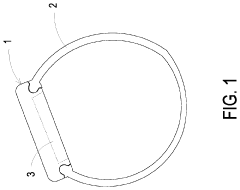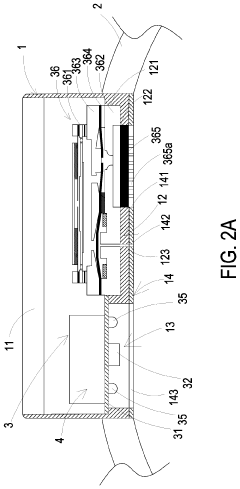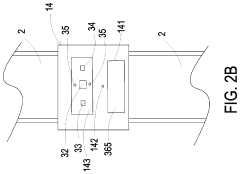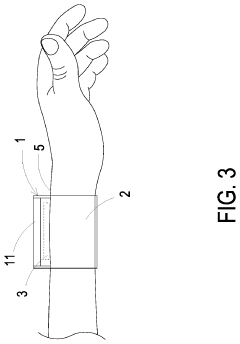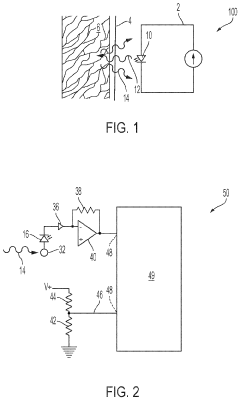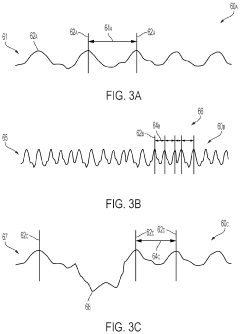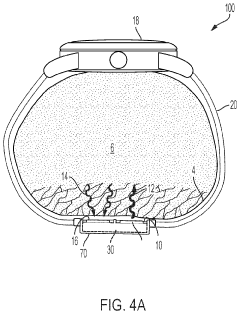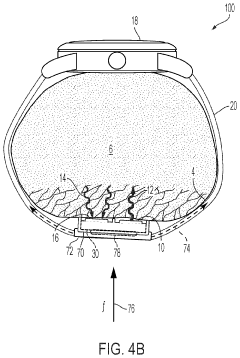How Vacuum Pumps Aid Development of Wearable Health Monitoring Devices
JUL 21, 20259 MIN READ
Generate Your Research Report Instantly with AI Agent
Patsnap Eureka helps you evaluate technical feasibility & market potential.
Vacuum Pump Tech in Wearables: Background and Objectives
Vacuum pump technology has played a pivotal role in the evolution of wearable health monitoring devices, marking a significant advancement in personal healthcare. The integration of these pumps into wearable devices represents a convergence of miniaturization, precision engineering, and biomedical innovation. This technological synergy aims to revolutionize continuous health monitoring, making it more accessible, accurate, and non-invasive for users across various demographics.
The journey of vacuum pump technology in wearables traces back to the early 2000s when researchers began exploring ways to enhance the capabilities of portable medical devices. The primary objective was to develop compact, energy-efficient vacuum systems that could be seamlessly incorporated into wearable form factors without compromising on performance or user comfort. This ambitious goal set the stage for a new era in personalized health monitoring.
As the field progressed, the focus shifted towards creating vacuum pumps that could operate at micro and nano scales, capable of precise fluid manipulation within miniaturized sensing platforms. These advancements were crucial in enabling the development of wearable devices that could accurately measure various physiological parameters, such as blood glucose levels, sweat composition, and even certain biomarkers indicative of disease states.
The technological evolution in this domain has been driven by several key objectives. Foremost among these is the enhancement of sensor sensitivity and specificity. Vacuum pumps have proven instrumental in creating controlled microenvironments within wearable devices, allowing for more accurate and reliable measurements of biological analytes. This capability is particularly valuable in continuous glucose monitoring systems and other devices requiring precise sample handling.
Another critical objective has been the reduction of power consumption and overall device size. Engineers and researchers have been working tirelessly to develop vacuum pump designs that are not only smaller but also more energy-efficient. This effort aligns with the broader goal of creating wearable health monitors that can operate for extended periods without frequent charging or battery replacement, thus improving user adherence and data continuity.
Furthermore, the integration of vacuum pump technology aims to expand the range of health parameters that can be monitored non-invasively. By enabling the collection and analysis of minute quantities of bodily fluids, such as interstitial fluid or sweat, these devices open up new possibilities for tracking various health indicators without the need for invasive procedures. This non-invasive approach not only enhances user comfort but also reduces the risk of complications associated with traditional monitoring methods.
The ongoing development of vacuum pump technology in wearables also seeks to address challenges related to durability, reliability, and cost-effectiveness. As these devices transition from research prototypes to consumer products, there is a growing emphasis on creating robust designs that can withstand daily wear and tear while maintaining consistent performance. Simultaneously, efforts are being made to streamline manufacturing processes and reduce production costs, making advanced health monitoring technologies more accessible to a broader population.
The journey of vacuum pump technology in wearables traces back to the early 2000s when researchers began exploring ways to enhance the capabilities of portable medical devices. The primary objective was to develop compact, energy-efficient vacuum systems that could be seamlessly incorporated into wearable form factors without compromising on performance or user comfort. This ambitious goal set the stage for a new era in personalized health monitoring.
As the field progressed, the focus shifted towards creating vacuum pumps that could operate at micro and nano scales, capable of precise fluid manipulation within miniaturized sensing platforms. These advancements were crucial in enabling the development of wearable devices that could accurately measure various physiological parameters, such as blood glucose levels, sweat composition, and even certain biomarkers indicative of disease states.
The technological evolution in this domain has been driven by several key objectives. Foremost among these is the enhancement of sensor sensitivity and specificity. Vacuum pumps have proven instrumental in creating controlled microenvironments within wearable devices, allowing for more accurate and reliable measurements of biological analytes. This capability is particularly valuable in continuous glucose monitoring systems and other devices requiring precise sample handling.
Another critical objective has been the reduction of power consumption and overall device size. Engineers and researchers have been working tirelessly to develop vacuum pump designs that are not only smaller but also more energy-efficient. This effort aligns with the broader goal of creating wearable health monitors that can operate for extended periods without frequent charging or battery replacement, thus improving user adherence and data continuity.
Furthermore, the integration of vacuum pump technology aims to expand the range of health parameters that can be monitored non-invasively. By enabling the collection and analysis of minute quantities of bodily fluids, such as interstitial fluid or sweat, these devices open up new possibilities for tracking various health indicators without the need for invasive procedures. This non-invasive approach not only enhances user comfort but also reduces the risk of complications associated with traditional monitoring methods.
The ongoing development of vacuum pump technology in wearables also seeks to address challenges related to durability, reliability, and cost-effectiveness. As these devices transition from research prototypes to consumer products, there is a growing emphasis on creating robust designs that can withstand daily wear and tear while maintaining consistent performance. Simultaneously, efforts are being made to streamline manufacturing processes and reduce production costs, making advanced health monitoring technologies more accessible to a broader population.
Market Analysis: Wearable Health Monitoring Devices
The wearable health monitoring devices market has experienced significant growth in recent years, driven by increasing health consciousness, technological advancements, and the rising prevalence of chronic diseases. This market segment encompasses a wide range of devices, including smartwatches, fitness trackers, ECG monitors, and biosensors, all designed to provide real-time health data to users and healthcare professionals.
The global wearable health monitoring devices market is projected to continue its upward trajectory, with a compound annual growth rate (CAGR) expected to remain in the double digits over the next five years. This growth is fueled by several factors, including the aging population, the increasing adoption of remote patient monitoring, and the growing emphasis on preventive healthcare.
Consumer demand for these devices is primarily driven by the desire for personal health management and fitness tracking. The ability to monitor vital signs, track physical activity, and receive personalized health insights has resonated strongly with health-conscious individuals. Additionally, the integration of advanced features such as sleep analysis, stress monitoring, and blood oxygen level measurement has expanded the appeal of these devices to a broader consumer base.
In the healthcare sector, wearable health monitoring devices are gaining traction as valuable tools for remote patient monitoring and chronic disease management. Healthcare providers are increasingly recognizing the potential of these devices to improve patient outcomes, reduce hospital readmissions, and lower healthcare costs. This trend has been further accelerated by the COVID-19 pandemic, which has highlighted the importance of remote health monitoring capabilities.
The market is characterized by intense competition among established technology companies, healthcare device manufacturers, and innovative startups. Key players are continuously investing in research and development to enhance device accuracy, battery life, and user experience. The integration of artificial intelligence and machine learning algorithms for data analysis and predictive health insights is emerging as a significant differentiator in the market.
Geographically, North America currently leads the wearable health monitoring devices market, followed by Europe and Asia-Pacific. However, the Asia-Pacific region is expected to witness the highest growth rate in the coming years, driven by increasing healthcare expenditure, rising disposable incomes, and growing awareness of personal health management in countries like China and India.
Despite the positive outlook, the market faces challenges such as data privacy concerns, regulatory hurdles, and the need for improved accuracy and reliability of measurements. Addressing these issues will be crucial for sustained market growth and wider adoption of wearable health monitoring devices across different demographics and healthcare settings.
The global wearable health monitoring devices market is projected to continue its upward trajectory, with a compound annual growth rate (CAGR) expected to remain in the double digits over the next five years. This growth is fueled by several factors, including the aging population, the increasing adoption of remote patient monitoring, and the growing emphasis on preventive healthcare.
Consumer demand for these devices is primarily driven by the desire for personal health management and fitness tracking. The ability to monitor vital signs, track physical activity, and receive personalized health insights has resonated strongly with health-conscious individuals. Additionally, the integration of advanced features such as sleep analysis, stress monitoring, and blood oxygen level measurement has expanded the appeal of these devices to a broader consumer base.
In the healthcare sector, wearable health monitoring devices are gaining traction as valuable tools for remote patient monitoring and chronic disease management. Healthcare providers are increasingly recognizing the potential of these devices to improve patient outcomes, reduce hospital readmissions, and lower healthcare costs. This trend has been further accelerated by the COVID-19 pandemic, which has highlighted the importance of remote health monitoring capabilities.
The market is characterized by intense competition among established technology companies, healthcare device manufacturers, and innovative startups. Key players are continuously investing in research and development to enhance device accuracy, battery life, and user experience. The integration of artificial intelligence and machine learning algorithms for data analysis and predictive health insights is emerging as a significant differentiator in the market.
Geographically, North America currently leads the wearable health monitoring devices market, followed by Europe and Asia-Pacific. However, the Asia-Pacific region is expected to witness the highest growth rate in the coming years, driven by increasing healthcare expenditure, rising disposable incomes, and growing awareness of personal health management in countries like China and India.
Despite the positive outlook, the market faces challenges such as data privacy concerns, regulatory hurdles, and the need for improved accuracy and reliability of measurements. Addressing these issues will be crucial for sustained market growth and wider adoption of wearable health monitoring devices across different demographics and healthcare settings.
Current Challenges in Wearable Vacuum Technology
The integration of vacuum technology into wearable health monitoring devices presents several significant challenges that researchers and engineers are actively working to overcome. One of the primary obstacles is miniaturization. Traditional vacuum pumps are often bulky and power-hungry, making them unsuitable for wearable applications. Developing compact, lightweight vacuum pumps that can maintain the required level of suction while consuming minimal energy is a complex engineering task.
Power management is another critical challenge. Wearable devices typically rely on small batteries with limited capacity. Vacuum pumps, even when miniaturized, can be energy-intensive. Balancing the power requirements of the vacuum system with other components of the wearable device, such as sensors and communication modules, requires sophisticated power management strategies and potentially novel energy harvesting techniques.
Noise and vibration reduction pose additional hurdles. Vacuum pumps generate both audible noise and physical vibrations, which can be disruptive and uncomfortable for users wearing the devices. Developing silent or near-silent vacuum technologies that operate smoothly without causing discomfort is essential for user acceptance and long-term wearability.
Durability and reliability are paramount concerns in wearable vacuum technology. These devices must withstand daily wear and tear, exposure to various environmental conditions, and potential impacts. Ensuring that the vacuum components can maintain their performance over extended periods without degradation or failure is crucial for the viability of wearable health monitoring devices.
Integration with flexible and stretchable materials presents another set of challenges. As wearable devices often need to conform to the body's contours, vacuum components must be designed to work effectively while being integrated into flexible substrates. This requires innovative materials science and engineering approaches to create vacuum channels and seals that can maintain their integrity under deformation.
Biocompatibility and safety are critical considerations, especially for devices in direct contact with the skin. Materials used in vacuum components must not cause allergic reactions or skin irritation. Additionally, ensuring that the suction levels are safe for prolonged skin contact without causing tissue damage or discomfort is a delicate balance to achieve.
Lastly, cost-effectiveness remains a significant challenge. For wearable health monitoring devices to achieve widespread adoption, they must be affordable. Developing vacuum technologies that are both high-performing and cost-effective for mass production is a complex task that requires innovative manufacturing processes and material choices.
Power management is another critical challenge. Wearable devices typically rely on small batteries with limited capacity. Vacuum pumps, even when miniaturized, can be energy-intensive. Balancing the power requirements of the vacuum system with other components of the wearable device, such as sensors and communication modules, requires sophisticated power management strategies and potentially novel energy harvesting techniques.
Noise and vibration reduction pose additional hurdles. Vacuum pumps generate both audible noise and physical vibrations, which can be disruptive and uncomfortable for users wearing the devices. Developing silent or near-silent vacuum technologies that operate smoothly without causing discomfort is essential for user acceptance and long-term wearability.
Durability and reliability are paramount concerns in wearable vacuum technology. These devices must withstand daily wear and tear, exposure to various environmental conditions, and potential impacts. Ensuring that the vacuum components can maintain their performance over extended periods without degradation or failure is crucial for the viability of wearable health monitoring devices.
Integration with flexible and stretchable materials presents another set of challenges. As wearable devices often need to conform to the body's contours, vacuum components must be designed to work effectively while being integrated into flexible substrates. This requires innovative materials science and engineering approaches to create vacuum channels and seals that can maintain their integrity under deformation.
Biocompatibility and safety are critical considerations, especially for devices in direct contact with the skin. Materials used in vacuum components must not cause allergic reactions or skin irritation. Additionally, ensuring that the suction levels are safe for prolonged skin contact without causing tissue damage or discomfort is a delicate balance to achieve.
Lastly, cost-effectiveness remains a significant challenge. For wearable health monitoring devices to achieve widespread adoption, they must be affordable. Developing vacuum technologies that are both high-performing and cost-effective for mass production is a complex task that requires innovative manufacturing processes and material choices.
Existing Vacuum Pump Solutions for Wearables
01 Improvements in vacuum pump design
Various advancements in vacuum pump design have been made to enhance efficiency and performance. These improvements include modifications to pump components, optimized fluid flow paths, and innovative sealing mechanisms. Such enhancements contribute to increased pumping speed, better vacuum levels, and improved overall reliability of the vacuum systems.- Rotary vacuum pump designs: Various designs of rotary vacuum pumps have been developed to improve efficiency and performance. These designs may include specific rotor configurations, sealing mechanisms, and lubrication systems to enhance vacuum generation and maintain consistent operation.
- Improvements in reciprocating vacuum pumps: Advancements in reciprocating vacuum pump technology focus on enhancing piston designs, valve systems, and cylinder arrangements. These improvements aim to increase pumping capacity, reduce wear, and improve overall efficiency in creating and maintaining vacuum conditions.
- Vacuum pump control systems: Modern vacuum pumps incorporate sophisticated control systems to optimize performance and energy efficiency. These systems may include sensors, variable speed drives, and intelligent algorithms to adjust pump operation based on demand and environmental conditions.
- Specialized vacuum pumps for semiconductor manufacturing: Vacuum pumps designed specifically for semiconductor manufacturing processes have been developed to meet the stringent requirements of the industry. These pumps often feature advanced materials, contamination control measures, and precise pressure regulation capabilities.
- Historical developments in vacuum pump technology: The evolution of vacuum pump technology can be traced through various historical patents, showcasing early innovations in pump designs, sealing methods, and vacuum generation techniques. These developments have laid the foundation for modern vacuum pump systems.
02 Specialized vacuum pumps for semiconductor manufacturing
Vacuum pumps tailored for semiconductor manufacturing processes have been developed to meet the stringent requirements of the industry. These pumps are designed to handle corrosive gases, maintain high cleanliness levels, and provide stable vacuum conditions. Features may include corrosion-resistant materials, advanced filtration systems, and precise pressure control mechanisms.Expand Specific Solutions03 Energy-efficient vacuum pump systems
Innovations in vacuum pump technology have focused on improving energy efficiency. These developments include the use of variable speed drives, optimized motor designs, and intelligent control systems. Such advancements result in reduced power consumption, lower operating costs, and improved environmental sustainability of vacuum pump operations.Expand Specific Solutions04 Multi-stage vacuum pump configurations
Multi-stage vacuum pump designs have been created to achieve higher vacuum levels and improved pumping efficiency. These configurations typically combine different pump types or multiple pumping stages in series. This approach allows for better gas handling capabilities, wider operating pressure ranges, and enhanced overall system performance.Expand Specific Solutions05 Vacuum pump monitoring and control systems
Advanced monitoring and control systems have been developed for vacuum pumps to optimize their performance and maintenance. These systems may include sensors for real-time monitoring of pump parameters, predictive maintenance algorithms, and remote monitoring capabilities. Such features enable improved pump reliability, reduced downtime, and more efficient operation of vacuum systems.Expand Specific Solutions
Key Players in Wearable Vacuum Pump Industry
The development of wearable health monitoring devices is in a growth phase, with the market expected to expand significantly in the coming years. The global market size for these devices is projected to reach billions of dollars by 2025, driven by increasing health awareness and technological advancements. The technology's maturity varies across different applications, with some areas more developed than others. Companies like Koninklijke Philips NV and QUALCOMM, Inc. are at the forefront, leveraging their expertise in healthcare and wireless technologies. Emerging players such as Bardy Diagnostics, Inc. and Lifeware Labs LLC are introducing innovative solutions, while established medical device manufacturers like Medela Holding AG and Fresenius Medical Care Deutschland GmbH are also entering this space, indicating a competitive and diverse landscape.
Koninklijke Philips NV
Technical Solution: Philips has developed advanced wearable health monitoring devices utilizing vacuum pump technology for enhanced sensor contact and data accuracy. Their approach integrates miniaturized vacuum pumps into flexible, skin-adherent patches that can continuously monitor vital signs such as heart rate, respiratory rate, and skin temperature. The vacuum-assisted attachment ensures consistent sensor contact, reducing motion artifacts and improving signal quality. Philips' system also incorporates microfluidic channels for sweat analysis, enabled by vacuum-driven fluid transport[1][3]. This multi-modal approach allows for comprehensive health monitoring, combining physical and biochemical measurements for a more holistic view of patient health.
Strengths: Improved sensor contact and data accuracy, multi-modal monitoring capabilities. Weaknesses: Potential for skin irritation with prolonged use, complexity of integrating multiple sensing modalities.
Pfeiffer Vacuum GmbH
Technical Solution: Pfeiffer Vacuum has developed specialized micro vacuum pumps tailored for wearable health monitoring devices. Their technology focuses on creating ultra-compact, low-power vacuum pumps that can be seamlessly integrated into wearable form factors. These pumps enable precise control of negative pressure, crucial for applications such as continuous glucose monitoring and drug delivery systems. Pfeiffer's pumps utilize advanced materials and optimized designs to achieve high efficiency and low noise operation, essential for user comfort in wearable devices. The company has also implemented smart control systems that allow dynamic adjustment of vacuum levels based on real-time sensor feedback, enhancing the overall performance and reliability of health monitoring wearables[2][5].
Strengths: Highly miniaturized and efficient vacuum pump technology, expertise in precision vacuum control. Weaknesses: May have higher cost compared to non-vacuum alternatives, potential for increased power consumption in some applications.
Innovative Vacuum Pump Designs for Health Monitoring
Wearable health monitoring device
PatentActiveUS11278242B2
Innovation
- A wearable health monitoring device combining a biometric monitoring module with a photoelectric sensor for optical blood pressure measurement and an air-pressure-based blood pressure meter for inflatable measurements, where the inflatable measurement data corrects the optical data, ensuring accuracy and portability.
Wearable health monitoring devices and methods
PatentInactiveUS20210022678A1
Innovation
- A wearable health monitoring device with a sensor unit housed in a configuration that applies an inward radial force via a band, utilizing a processor to interpret photoplethysmogram data and adjust fit based on pressure-sensitive feedback to maintain optimal contact and data accuracy, and potentially integrated with a system for administering medicine upon detection of anomalies.
Regulatory Framework for Medical Wearables
The regulatory framework for medical wearables is a critical aspect of the development and deployment of wearable health monitoring devices. As these devices become increasingly sophisticated and integrated into healthcare systems, regulatory bodies worldwide have been adapting their guidelines to ensure patient safety, data privacy, and device efficacy.
In the United States, the Food and Drug Administration (FDA) plays a pivotal role in regulating medical wearables. The FDA classifies these devices based on their intended use and potential risk to patients. Many wearable health monitoring devices fall under Class II, requiring premarket notification (510(k)) before they can be marketed. However, some low-risk devices may be classified as Class I, subject to general controls but exempt from premarket notification.
The European Union has implemented the Medical Device Regulation (MDR), which came into full effect in May 2021. This regulation provides a comprehensive framework for medical devices, including wearables. Under the MDR, manufacturers must demonstrate clinical evidence of their devices' safety and performance, and implement a robust quality management system.
Data protection regulations, such as the General Data Protection Regulation (GDPR) in the EU and the Health Insurance Portability and Accountability Act (HIPAA) in the US, also significantly impact the development of wearable health monitoring devices. These regulations mandate strict data protection measures and user consent protocols for collecting and processing personal health information.
Interoperability standards are another crucial aspect of the regulatory framework. Organizations like the IEEE and HL7 have developed standards to ensure that wearable devices can seamlessly integrate with existing healthcare IT systems. These standards facilitate data exchange and interoperability across different platforms and devices.
Regulatory bodies are also addressing the unique challenges posed by AI and machine learning algorithms integrated into wearable devices. The FDA has proposed a regulatory framework for AI/ML-based Software as a Medical Device (SaMD), which aims to ensure the safety and effectiveness of these rapidly evolving technologies.
As the technology behind wearable health monitoring devices continues to advance, regulatory frameworks are expected to evolve. Future regulations may focus on areas such as real-time data monitoring, remote patient management, and the integration of wearables into clinical decision support systems. Manufacturers and developers must stay abreast of these regulatory changes to ensure compliance and market success.
In the United States, the Food and Drug Administration (FDA) plays a pivotal role in regulating medical wearables. The FDA classifies these devices based on their intended use and potential risk to patients. Many wearable health monitoring devices fall under Class II, requiring premarket notification (510(k)) before they can be marketed. However, some low-risk devices may be classified as Class I, subject to general controls but exempt from premarket notification.
The European Union has implemented the Medical Device Regulation (MDR), which came into full effect in May 2021. This regulation provides a comprehensive framework for medical devices, including wearables. Under the MDR, manufacturers must demonstrate clinical evidence of their devices' safety and performance, and implement a robust quality management system.
Data protection regulations, such as the General Data Protection Regulation (GDPR) in the EU and the Health Insurance Portability and Accountability Act (HIPAA) in the US, also significantly impact the development of wearable health monitoring devices. These regulations mandate strict data protection measures and user consent protocols for collecting and processing personal health information.
Interoperability standards are another crucial aspect of the regulatory framework. Organizations like the IEEE and HL7 have developed standards to ensure that wearable devices can seamlessly integrate with existing healthcare IT systems. These standards facilitate data exchange and interoperability across different platforms and devices.
Regulatory bodies are also addressing the unique challenges posed by AI and machine learning algorithms integrated into wearable devices. The FDA has proposed a regulatory framework for AI/ML-based Software as a Medical Device (SaMD), which aims to ensure the safety and effectiveness of these rapidly evolving technologies.
As the technology behind wearable health monitoring devices continues to advance, regulatory frameworks are expected to evolve. Future regulations may focus on areas such as real-time data monitoring, remote patient management, and the integration of wearables into clinical decision support systems. Manufacturers and developers must stay abreast of these regulatory changes to ensure compliance and market success.
Energy Efficiency in Wearable Vacuum Pumps
Energy efficiency is a critical factor in the development of wearable vacuum pumps for health monitoring devices. As these devices become increasingly compact and portable, the need for efficient power consumption becomes paramount. Traditional vacuum pumps often consume significant amounts of energy, which can limit the operational time of wearable devices and impact user experience.
Recent advancements in miniaturization and materials science have led to the development of more energy-efficient vacuum pump designs specifically tailored for wearable applications. These pumps utilize innovative technologies such as piezoelectric actuators, microfluidic channels, and smart control systems to optimize power consumption while maintaining the necessary vacuum levels for accurate health monitoring.
One of the key approaches to improving energy efficiency in wearable vacuum pumps is the implementation of adaptive power management systems. These systems dynamically adjust the pump's operation based on real-time monitoring needs, reducing unnecessary energy expenditure during periods of low activity. By intelligently controlling the pump's duty cycle and power output, these systems can significantly extend the battery life of wearable devices without compromising their monitoring capabilities.
Another area of focus is the development of low-friction materials and coatings for pump components. By reducing internal friction and mechanical losses, these advanced materials minimize energy dissipation during pump operation. Additionally, the integration of energy recovery mechanisms, such as regenerative braking systems adapted for rotary pump designs, allows for the capture and reuse of energy that would otherwise be lost as heat or vibration.
Researchers are also exploring the potential of hybrid pump designs that combine multiple vacuum generation mechanisms. These hybrid systems can leverage the strengths of different pump types to achieve optimal energy efficiency across various operating conditions. For example, a combination of electroosmotic and mechanical pumping mechanisms can provide high vacuum levels during active monitoring periods while maintaining a low-power baseline vacuum during standby modes.
The pursuit of energy efficiency in wearable vacuum pumps extends beyond the pump itself to encompass the entire system design. This holistic approach includes optimizing the fluidic pathways, reducing dead volume, and improving the overall thermal management of the device. By addressing these system-level factors, developers can further enhance the energy efficiency of wearable health monitoring devices, ultimately leading to longer battery life and improved user adoption.
Recent advancements in miniaturization and materials science have led to the development of more energy-efficient vacuum pump designs specifically tailored for wearable applications. These pumps utilize innovative technologies such as piezoelectric actuators, microfluidic channels, and smart control systems to optimize power consumption while maintaining the necessary vacuum levels for accurate health monitoring.
One of the key approaches to improving energy efficiency in wearable vacuum pumps is the implementation of adaptive power management systems. These systems dynamically adjust the pump's operation based on real-time monitoring needs, reducing unnecessary energy expenditure during periods of low activity. By intelligently controlling the pump's duty cycle and power output, these systems can significantly extend the battery life of wearable devices without compromising their monitoring capabilities.
Another area of focus is the development of low-friction materials and coatings for pump components. By reducing internal friction and mechanical losses, these advanced materials minimize energy dissipation during pump operation. Additionally, the integration of energy recovery mechanisms, such as regenerative braking systems adapted for rotary pump designs, allows for the capture and reuse of energy that would otherwise be lost as heat or vibration.
Researchers are also exploring the potential of hybrid pump designs that combine multiple vacuum generation mechanisms. These hybrid systems can leverage the strengths of different pump types to achieve optimal energy efficiency across various operating conditions. For example, a combination of electroosmotic and mechanical pumping mechanisms can provide high vacuum levels during active monitoring periods while maintaining a low-power baseline vacuum during standby modes.
The pursuit of energy efficiency in wearable vacuum pumps extends beyond the pump itself to encompass the entire system design. This holistic approach includes optimizing the fluidic pathways, reducing dead volume, and improving the overall thermal management of the device. By addressing these system-level factors, developers can further enhance the energy efficiency of wearable health monitoring devices, ultimately leading to longer battery life and improved user adoption.
Unlock deeper insights with Patsnap Eureka Quick Research — get a full tech report to explore trends and direct your research. Try now!
Generate Your Research Report Instantly with AI Agent
Supercharge your innovation with Patsnap Eureka AI Agent Platform!
